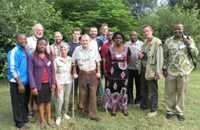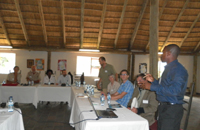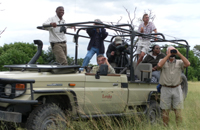Slaty Egret workshop in Maun, Botswana
 Bonn,
Bonn,
5 April 2011 - An important step towards
better protection of the Slaty Egret (Egretta vinaceigula)
was
taken in March in form of a three-day, multi-stakeholder,
action-planning workshop, which took place from 3 - 5
March 2011 at the Thamalakane River Lodge in Maun, Botswana.
The aim
of the workshop was to share information
on the numbers, distribution,
threats and conservation status of
the Slaty Egret in each Range State,
with the aim of compiling an International Single Species
Action Plan (ISSAP) for
the species, to be presented to the 5th Meeting of the
Parties to AEWA (MOP5, France, 14-18 May 2012).
The Vulnerable Slaty Egret has a small and
declining population with very limited information available
about its status and distribution, and is hence considered
to be in crucial need of an ISSAP. The core breeding area
of this AEWA species is virtually confined to the Okavango
Delta, the world’s largest inland delta.
The workshop was jointly organized by BirdLife Botswana
and the AEWA Secretariat, with valuable facilitation from
the Botswana Wildlife Department. It was attended by 15 participants
comprising Government representatives and experts from the
six key Range States of the Slaty Egret (Angola, Botswana,
Namibia, South Africa, Zambia and Zimbabwe) as well as AEWA
partner organizations. The AEWA Secretariat was represented
by its Technical Officer, Mr. Sergey Dereliev, and the Coordinator
for the African Initiative, Ms. Evelyn Moloko.
 A
A
warm welcome from Dr. Lucas Rutina of the Department of Wildlife
of Botswana, Mr. Pete Hancock
of BirdLife Botswana,
and Sergey Dereliev started off the workshop. It then focused
on presenting AEWA and its Single Species Action Planning
and implementation process as well as determining the Slaty
Egret’s
population distribution and migration, status and dynamics,
status of knowledge and scientific monitoring efforts in
each Range State.
Presentations were interspersed with very lively and informative
discussion, and followed by an in-depth problem analysis
which identified and prioritized threats across the entire
range. The key threats identified include habitat destruction,
for instance from dams, drainage and reed cutting, destruction
of roost and nest sites by fires, and lack of scientific
data on the species’ distribution and breeding biology.
The workshop subsequently determined an overall goal for
the ISSAP, as well as specific objectives for tackling the
main threats, each with expected results and key actions
to be undertaken, with specifications for the Range States
concerned. The recommended actions centered around promoting
enforcement of regulations to minimize destruction of habitats
caused by anthropic activities and supporting/promoting scientific
research for more information, amongst others, on the species’ distribution,
population size and breeding biology. The draft ISSAP is
to be presented to MOP5 for approval in 2012, and will be
applicable for implementation in all six Range States present
at the workshop.
 A one-day field trip to the Moremi Game Reserve situated
A one-day field trip to the Moremi Game Reserve situated
within the Okavango Delta Ramsar Site was also part of the
workshop programme. This visit to one of the core known breeding
areas for the Slaty Egret was an occasion for the workshop
participants to get a first-hand impression of the species’ habitat
and observe birds in their natural environment. Despite being
notoriously difficult to find and identify in the wild, the
participants had a great opportunity to see 14 Slaty Egrets
feeding in the floodplains of Moremi Game Reserve. The Okavango
Delta is a key site for many other AEWA species, some of
which the workshop participants saw on the trip, such as
the Vulnerable Wattled Crane, a number of herons and egrets,
Pink-backed Pelicans and African Open-billed Storks.
The workshop terminated with a session promoting the accession
to AEWA of those Range States which are not yet Contracting
Parties (Angola, Botswana, Namibia, Zambia and Zimbabwe).
Information on the current status of the accession process
and constraints faced were shared and suggestions on possible
action to be taken at the national level as well as by the
AEWA Secretariat were put forward. It was generally agreed
that these countries needed to become members to the Agreement
in order to facilitate and promote coordinated conservation
action on a flyway scale.
the outcomes of the workshop and stressed their eagerness to
continue promoting to the conservation of the Slaty Egret at
the national level.
The AEWA Secretariat would like to thank the Governments
of Switzerland, Germany and France which made this very productive
workshop possible by providing voluntary financial contributions.
Last updated on 16 June 2014


